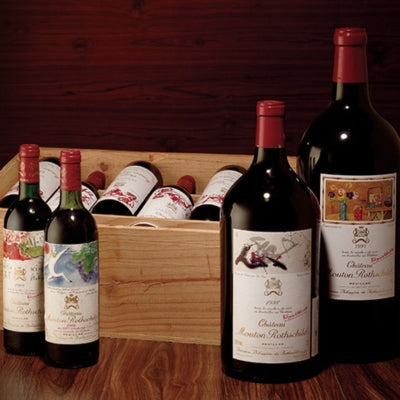
The 20th century abstract art labels of Mouton Rothschild
Mouton Rothschild is not only known for its legendary wines but also for its iconic collaborations with some of the world’s greatest artists. Since 1945, the First Growth estate has commissioned renowned artists to create unique labels for each vintage, resulting in a diverse collection that reflects various artistic styles and themes.
Among these collaborations, abstract art played a crucial role in defining several standout labels of the 20th century. Characterized by its use of color, form, and movement, abstraction seeks to evoke emotion and convey meaning beyond literal imagery.
What is abstract art?
As artist Arshile Gorky once said, "Abstraction allows man to see with his mind what he cannot see physically with his eyes." Unlike traditional representational art, abstraction does not seek to depict reality. Instead, it uses shapes, colors, and movement to evoke emotion and express ideas beyond the tangible.
Pioneered by visionaries like Wassily Kandinsky, Piet Mondrian, and Jackson Pollock, abstraction became a defining force of the 20th century as artists sought new ways to express the chaos and uncertainty of the modern world. The devastation of two world wars, rapid industrialization, and shifting cultural landscapes made traditional realism feel inadequate. Instead, abstraction captured raw emotion, subconscious thought, and the fractured nature of reality.
From Kandinsky’s spiritual compositions to Pollock’s explosive energy and Rothko’s meditative color fields, abstract art became a response to a world in flux - where meaning was felt rather than seen.
Wassily Kandinsky, a pioneer of abstract art, lent his visionary style to the 1971 Mouton Rothschild label. The artwork, originally painted in 1939 during his "architectural" period, embodies his signature exploration of form, color, and movement. Kandinsky believed that abstraction could evoke emotions beyond the constraints of representational art, making his work a fitting choice for a wine that is itself an expression of artistry. The original painting now resides in the Georges Pompidou Centre in Paris.
Hisao Domoto, the first Japanese artist to be commissioned for a Mouton Rothschild label, brought his bold, abstract style to the 1979 vintage. Trained in traditional Japanese painting before embracing Western abstraction, Domoto developed a unique visual language inspired by the theory of Informality. His work often explored themes of movement and continuity, characterized by layered, contrasting colors and fluid, rhythmic compositions. For Mouton Rothschild, Domoto created a mesmerizing interplay of radiant hues, evoking a sense of dynamic energy and interconnectedness. The vibrant, textured forms on the label reflect his fascination with chain reactions and the harmony of chaos and order - an apt metaphor for the artistry of fine winemaking. His contribution remains one of the most striking and unconventional labels in Mouton Rothschild’s history.
Shocking, controversial, grotesque - yet also epic and among the most influential German art of the past 50 years. Though his paintings, sculptures, and prints often feature recognizable imagery, they transcend mere representation. Baselitz’s art is fundamentally abstract, not because it lacks subject matter, but because it questions its own meaning even before the viewer does.
His 1989 Mouton Rothschild label is no exception. Featuring his signature upside-down composition, Baselitz reimagines Mouton’s emblematic rams in a way that mirrors the turmoil of the time - the fall of the Berlin Wall. The inversion disrupts expectations, forcing viewers to reconsider perspective, meaning, and tradition. Accompanied by the words "Drüben sein jetzt hier" ("Over there is now over here"), the label becomes a statement on history, reunification, and shifting realities.
Dutch painter Karel Appel, a founding member of the avant-garde Cobra movement, brought his bold, expressive style to the 1994 Mouton Rothschild label. Known for his energetic brushwork and vibrant colors, Appel’s work is rooted in spontaneity and raw emotion, embracing the uninhibited spirit of abstract expressionism. For Mouton Rothschild, he depicted two lively figures in a wild dance around a bottle, evoking the exuberance and passion that fine wine inspires. His playful yet dynamic composition suggests the release of energy, as if unlocking the essence of the wine within. As the first Dutch artist to illustrate a Mouton Rothschild label, Appel’s contribution is a celebration of movement, joy, and the boundless creativity that defines both great art and great wine.
Antoni Tàpies, one of the most influential figures in post-war abstract art, created a striking design for the 1995 Mouton Rothschild label. Famous for his unique fusion of Eastern philosophy and Western avant-garde techniques, Tàpies often used raw, textured surfaces and unconventional materials to explore themes of human struggle, spirituality, and the passage of time. His label for Mouton Rothschild reflects this approach - featuring a bold, minimalist composition with a nose, two hearts, a mouth, and an eye, symbolizing the essence of sensory experience. With its stark yet poetic imagery, the artwork captures the anticipation, complexity, and pleasure that fine wine promises in every bottle.
Just as abstract art seeks to engage the senses, challenging perceptions, fine wine requires an appreciation for subtlety. Abstract art focuses on timeless, universal emotions - just as wine, a product of its vintage, transcends time and place.
Want to read more? Take a look at some of our other blogs:
Also in News



